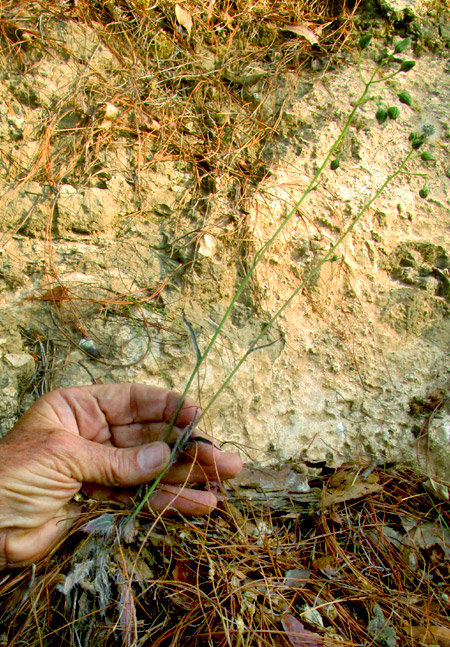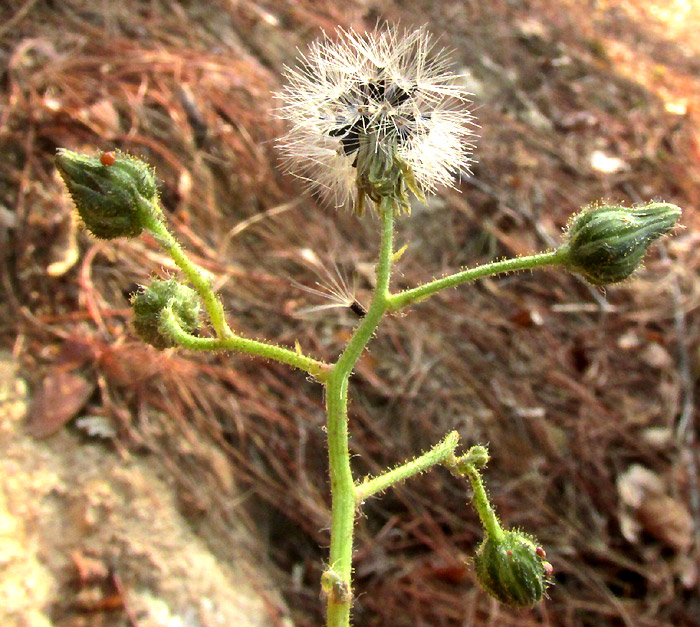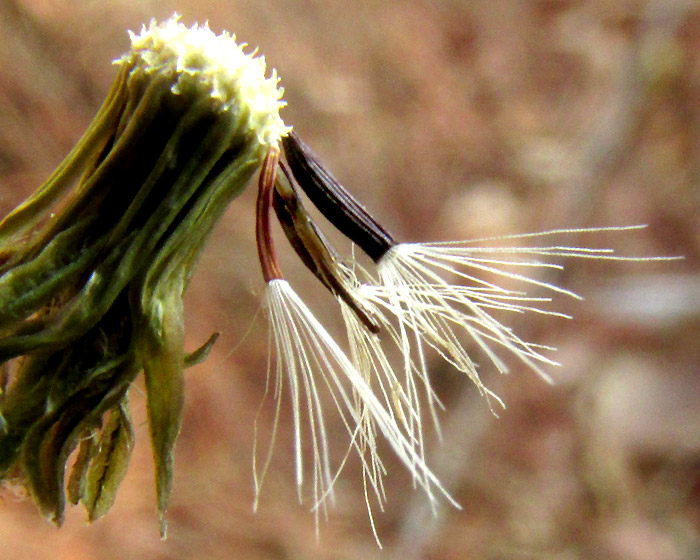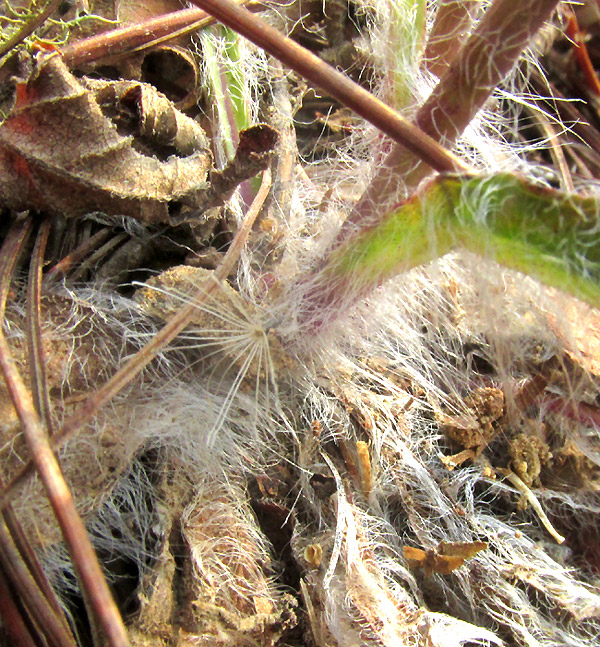Excerpts from Jim Conrad's
Naturalist Newsletter
Entry dated April 19, 2024, from notes taken about 1.5km northeast of Puerto de los Velazquez, Municipality of Pinal de Amoles; N21.134°, W99.667°, elevation ~2760 meters (~9050 feet); oak/pine forest on limestone bedrock; east-central Querétaro state, MÉXICO
PRINGLE'S HAWKWEED

At the base of an old roadcut through tuff, or compacted volcanic ash, the above wildflower's leaves were dead and dried-up, and its flowers had long disappeared. However, atop its two tall, slender stems, fruiting heads were releasing their one-seeded, cypsela-type fruits.

Above, the green, scaly, teardrop-shaped items earlier were flowering heads, but now the corollas have fallen away, the scaly involucre has closed up, and they contain maturing cypselae. Once the fruits inside them are mature and the white, parachute-like pappuses atop the fruits are ready to expand, the structure will open up, its slender scales will turn downward, and it will become a fruiting head like the one at the picture's top. That head, similar to those produced by closely related dandelions, is awaiting a breeze to carry away its parachuted, black cypselae.

In the above image, all but three cypselae have been dispersed. The cypselae's size, their conspicuous ribs, and shape -- especially developing no slender neck between the cypsela body and the pappus -- is an important field mark for identifying the genus in our plant's family, which is the vast Composite/Aster/Sunflower Family, the Asteraceae.

At this point I suspected we had one of about 4631 species currently recognized in Kew's Plants of the World Online database, of the genus Hieracium. Species of Hieracium, commonly referred to as hawkweeds, often are encountered as wildflowers and weeds, and the ones I know usually appear on dry ground. Anyone paying attention to the local vegetation soon becomes familiar with the hawkweed species' typical size and general form. Our plant's hairiness, which includes gland-tipped hairs, and its fruiting heads similar to those of dandelions, are good field marks. However, this species was even hairier than most.

Hairs were longest and densest at leaf bases. Note that this species' leaves develop no real petioles, but rather the slender blades gradually diminish to the leaves' bases, and the bases don't enlarge into "ears" as in some species.

The hairiness is most spectacular at the plant's base.
The Flora del Bajío documenting flowering plants in this part of upland, central Mexico, known as the Bajío, describes 15 hawkweed species found here. Among those 15 species, any plant with such very long, soft hairs interweaving with one another as seen above, is HIERACIUM PRINGLEI, Pringle's Hawkweed.
Pringle's Hawkweed mostly inhabits upland forests with oaks and pines from the southwestern US's border region in Arizona and New Mexico south through upland Mexico into Guatemala. The Flora describes it as not particularly common, but because of its large distribution currently isn't threatened with extinction.
I find no mention of this species being used in traditional Mexican medicine, though certain hawkweeds are known as useful. In the 2021 study by Johanna Willer and others entitled "Ethnopharmacology, phytochemistry, and bioactivities of Hieracium L. and Pilosella Hill (Cichorieae, Asteraceae) species," it's said that popular uses of hawkweeds include treatments of skin, gastric, and intestinal diseases as well as respiratory and vascular ailments. Certain taxa are generally used as antibiotics, antiseptics, antidiabetics, tonics, antiepileptics, antiphlogistics (against inflammation), emetics, wound healing drugs, astringents, haemostatics, and detoxicants, plus sometimes animals eat them, and the plants are involved with charming rituals.
I'm not perfectly comfortable with this identification. The Flora of North America remarks that "Most plants referable to Hieracium are apomictic (reproducing from asexually produced seeds)." It goes on to say that this often results in the production of morphological variants which can spread to the regional level; and such variants frequently are published as new species. This has resulted in about 9000 names being published, most of which now are listed as synonyms.
With regard to our plant, in our area another taxon, Hieracium dysonymum, also develops very long hairs like our individual's. Descriptions of the two species appear to separate them mostly by how much the long hairs entangle with one another. My impression is that there's a complex of long-haired species which hasn't been studied enough to clearly delineate species boundaries; or maybe that there are no clear boundaries, just ill-defined taxa in the process of vigorously evolving.